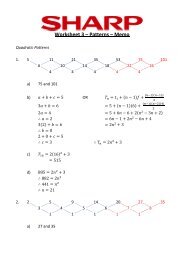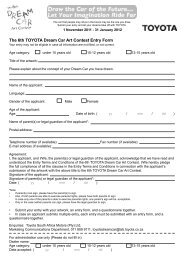curriculum and assessment policy statement (caps) - Department of ...
curriculum and assessment policy statement (caps) - Department of ...
curriculum and assessment policy statement (caps) - Department of ...
- No tags were found...
You also want an ePaper? Increase the reach of your titles
YUMPU automatically turns print PDFs into web optimized ePapers that Google loves.
Content Area Content Clarification / Notes / Activities/ExamplesRecommended Resourceso “Which <strong>of</strong> the circles is the smallest? s<strong>and</strong>/on the floor/groundApproximateDurationSuggested FormalAssessmentRecognise <strong>and</strong> identify thenumber symbol <strong>and</strong>number name that involvenumber 1 to 8.ContinuedSymmetry in selfwith focus on the“front <strong>and</strong> back”concepts• Develop the awareness that one’s body has two sides <strong>and</strong> that each sidecan move independentlyExamples:1. Explain how the body is divided into two through the middle. Allow the learnersto experience this in a mirror.2. A rope could also be hung from the top <strong>of</strong> the learner’s head to the bottom <strong>of</strong>his/her toes to show that the body is divided in to two parts.3. Point out all the body parts that a person has two <strong>of</strong> (the one side/the other sideor the left / the right).4. Point out all the body parts that a person has only one <strong>of</strong> e.g. mouth, nose, <strong>and</strong>navel but cut in half the parts look exactly the same.5. Learners execute instructions e.g. “place the h<strong>and</strong> <strong>of</strong> one side on the knee <strong>of</strong> theother side” or “place the left foot on the chair”.6. Point out that people <strong>and</strong> objects have a front <strong>and</strong> a back.7. Symmetrical control: The learners will be able to control both sides <strong>of</strong> the bodyby doing the following exercises:- Marching, lifting the knees high, stiff ‘tin soldier’ marching.- Cross arms, cross legs while marching.- Moving in response to music or an imaginary situation e.g. walking in mud,on ice, on hot bricks, etc.- Moving with a partner i.e. sitting on the carpet, feet together e.g. sawing atree, pushing/pulling a heavy load, rowing a boat.Learners should perform instructions with closed eyes.Action songs/rhymes e.g. “I put my leftfoot in”MirrorRope1 daysSolve addition <strong>and</strong>subtraction problems orally,using story sums <strong>and</strong>counters/objects withanswers up to the number 8.Underst<strong>and</strong>s to order <strong>and</strong>compare collections <strong>of</strong>objects using “morethan/less than” <strong>and</strong> “equalto” that involve number 1-10Distinguish the location <strong>of</strong> asound (auditory pattern)Recognise, identify <strong>and</strong>name a rectangle.Recognise visible properties<strong>of</strong> a rectangle informally.Recognise <strong>and</strong> identify whiteGain knowledge <strong>of</strong> theposition <strong>of</strong> two or moreobjects in relation to thelearner.Underst<strong>and</strong> that thecollecting <strong>and</strong> sorting <strong>of</strong>objects can eventually berepresented in a graph.93 | P age
















